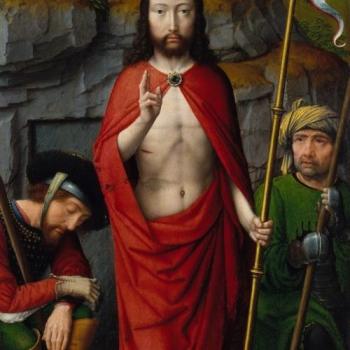One of the more subtle things Matthew likes to do is teach via a sort of “sacred geography”. So, he tells us, after the arrest of John the Baptist, Jesus leaves Judea and, in a strange but obviously deliberate move, continues on from Nazareth to Capernaum on the Sea of Galilee. Why?
Matthew tells us. He notes pointedly that Capernaum is, in the “territory of Zebulun and Naphtali” (Matthew 4:13). Zebulun and Naphtali were the very first tribes of the northern kingdom of Israel deported by the Assyrians 700 years before Matthew wrote. It has been an extremely long time since that region was called the area of Zebulun and Naphtali. So to get the hang of how odd it is that Matthew describes the area in that way, imagine a modern-day writer referring to Paris as being in the “territory of the Franks”. We immediately grasp that Matthew is trying to get us to think historically. He then follows this up with a citation from Isaiah. And not just any part of Isaiah, but Isaiah 9:1-2 which is right in the heart of what scholars call “the book of Immanuel” found in Isaiah 7-11 and which Matthew has already quoted twice before. His point then? That Jesus — the son of David — is beginning his restoration of the Davidic kingdom (and his transformation of it into the kingdom of heaven) at ground zero where God’s covenant judgment had fallen seven centuries before.
Near the end of Matthew 9 we reach a critical turning point. On the one hand, as Jesus preaches and performs miracles in “the land of Zebulun and the land of Naphtali, Galilee of the Gentiles” (that is, the region that was once the northern kingdom of Israel), Matthew tells us, “the crowds marveled, saying, ‘never was anything like this seen in Israel'” (9:33). On the other hand, the attitude of the Pharisees crystallizes into entrenched hostility: “He casts out demons by the prince of demons” (9:34).
Why is this a critical turning point? Matthew gives us a clue: “When he saw the crowds, he had compassion for them, because they were harassed and helpless, like sheep without a shepherd” (9:36). The image of shepherd and sheep is not an offhand remark for Matthew. It is profound and rich and rooted in Ezekiel 34. In that passage, which is directed to the northern kingdom of Israel, the false shepherds of Israel are castigated by the Lord for shearing, killing, and eating, rather than feeding, the sheep. At the end of Ezekiel’s prophecy the Lord announces, “Behold, I, I myself will search for my sheep, and will seek them out. As a shepherd seeks out his flock when some of his sheep have been scattered abroad, so will I seek out my sheep; and I will rescue them from all places where they have been scattered on a day of clouds and thick darkness. And I will bring them out from the peoples, and gather them from the countries” (Ezekiel 34:11-13). In other words, Ezekiel promises restoration for the “ten lost tribes of Israel” who were deported by Assyrians seven centuries before Christ. Through the prophet God promises that “I myself will be the shepherd of my sheep” (Ezekiel 34:15) and deliver them from their bad shepherds as well as from their enemies.
The Pharisees considered themselves to be the true shepherds of Israel. But the reality is, they were Jews from the tribe of Judah, and didn’t care two hoots about the descendants of the northern kingdom of Israel. In fact, Rabbi Akiva, a Pharisaic Rabbi, said, “The ten tribes will have no share in the life of the world to come.” So, in Matthew 10, Jesus begins the act of restoration promised in Ezekiel 34. He calls twelve disciples and empowers them to be apostles. A disciple is a learner. But an apostle is one who is sent. The twelve disciples have learned, watched, and studied. Now Jesus sends them out.
And who are they sent out to? “These twelve Jesus sent out, charging them, ‘Go nowhere among the Gentiles, and enter no town of the Samaritans, but go rather to the lost sheep of the house of Israel‘” (Matthew 10:5-6). Jesus, in other words, is preoccupied with Ezekiel’s vision of restoration, not just of the house of David, but of the northern kingdom of Israel as well. For the Incarnate God is the good shepherd of Ezekiel’s prophecy. Moreover, he is (as Matthew has repeatedly declared) the “son of David”. And, oddly enough, Ezekiel tells us not only that God will be the shepherd of Israel but that, “I will set up over them one shepherd, my servant David, and he shall feed them: he shall feed them and be their shepherd. And I, the LORD, will be their God, and my servant David shall be prince among them; I, the LORD, have spoken. I will make with them a covenant of peace” (Ezekiel 34:23-25).
That is why Jesus, Son of God and son of David, chooses twelve apostles. He who “in the new world… shall sit on his glorious throne” declares that “you have followed me will also sit on twelve thrones, judging the twelve tribes of Israel” (Matthew 19:28). Jesus’ vision is nothing less than the restoration of all twelve tribes, even though the tribes have not been twelve since 930 B.C. and the northern kingdom was destroyed in 722 B.C.
There’s a lot going on in yesterday’s readings. And, rather like our current pope, it’s all about Christ reaching out to the riff raff and poor and losers that the Pharisees despise.











